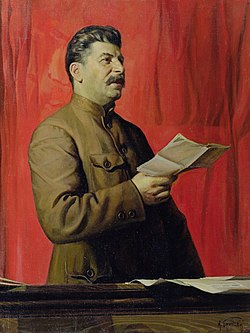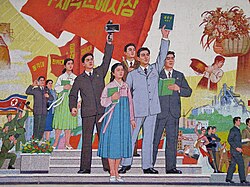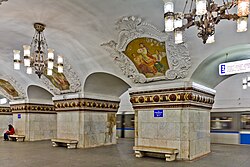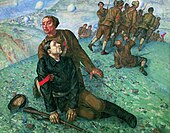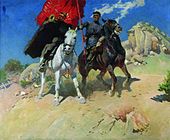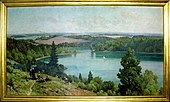Socialist realism
This article needs additional citations for verification. (April 2021) |
Top to bottom: Portrait of J.V. Stalin by Isaak Brodsky (1933); Mural in North Korea; Kiyevskaya station in the Moscow Metro | |
| Years active | 1932 – present |
|---|---|
| Location | Socialist countries |
| Influences | Marxism, Realism |
Socialist realism was the official cultural doctrine of the Soviet Union that mandated an idealized representation of life under socialism in literature and the visual arts. The doctrine was first proclaimed by the First Congress of Soviet Writers in 1934 as approved method for Soviet cultural production in all media.[1] In the aftermath of World War II, socialist realism was adopted by the communist states that were politically aligned with the Soviet Union.[2] The primary official objective of socialist realism was "to depict reality in its revolutionary development" although no formal guidelines concerning style or subject matter were provided.[1]
It was usually characterized by unambiguous narratives or iconography relating to the Marxist–Leninist ideology, such as the emancipation of the proletariat.[3] Despite its name, the figures in the style are very often highly idealized, especially in sculpture, where it often leans heavily on the conventions of classical sculpture. Although related, it should not be confused with social realism, a type of art that realistically depicts subjects of social concern and was popularized in the United States during the 1930s,[4] or other forms of "realism" in the visual arts. Socialist realism was made with an extremely literal and obvious meaning, usually showing an idealized Soviet society. Socialist realism was usually devoid of complex artistic meaning or interpretation.[5][6]
Socialist realism was the predominant form of approved art in the Soviet Union from its development in the early 1920s to its eventual fall from official status beginning in the late 1960s until the collapse of the Soviet Union in 1991.[7][8] While other countries have employed a prescribed canon of art, socialist realism in the Soviet Union persisted longer and was more restrictive than elsewhere in Europe.[9]
History
[edit]Development
[edit]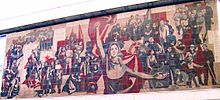
Socialist realism was developed by many thousands of artists, across a diverse society, over several decades.[10] Early examples of realism in Russian art include the work of the Peredvizhnikis and Ilya Yefimovich Repin. While these works do not have the same political connotation, they exhibit the techniques exercised by their successors. After the Bolsheviks took control of Russia on October 25, 1917, there was a marked shift in artistic styles. There had been a short period of artistic exploration in the time between the fall of the Tsar and the rise of the Bolsheviks.
Shortly after the Bolsheviks took control, Anatoly Lunacharsky was appointed as head of Narkompros, the People's Commissariat for Enlightenment.[10] This put Lunacharsky in the position of deciding the direction of art in the newly created Soviet state. Although Lunacharsky did not dictate a single aesthetic model for Soviet artists to follow, he developed a system of aesthetics based on the human body that would later help to influence socialist realism. He believed that "the sight of a healthy body, intelligent face or friendly smile was essentially life-enhancing."[11] He concluded that art had a direct effect on the human organism and under the right circumstances that effect could be positive. By depicting "the perfect person" (New Soviet man), Lunacharsky believed art could educate citizens on how to be the perfect Soviets.[11]
Debate within Soviet art
[edit]
There were two main groups debating the fate of Soviet art: futurists and traditionalists. Russian Futurists, many of whom had been creating abstract or leftist art before the Bolsheviks, believed communism required a complete rupture from the past and, therefore, so did Soviet art.[11] Traditionalists believed in the importance of realistic representations of everyday life. Under Lenin's rule and the New Economic Policy, there was a certain amount of private commercial enterprise, allowing both the futurists and the traditionalists to produce their art for individuals with capital.[12] By 1928, the Soviet government had enough strength and authority to end private enterprises, thus ending support for fringe groups such as the futurists. At this point, although the term "socialist realism" was not being used, its defining characteristics became the norm.[13]
According to the Great Russian Encyclopedia, the term was first used in press by chairman of the organizing committee of the Union of Soviet Writers, Ivan Gronsky in Literaturnaya Gazeta on May 23, 1932.[14] The term was approved in meetings that included politicians of the highest level, including Joseph Stalin.[15] Maxim Gorky, a proponent of literary socialist realism, published a famous article titled "Socialist Realism" in 1933.[15] During the Congress of 1934, four guidelines were laid out for socialist realism.[16] The work must be:
- Proletarian: art relevant to the workers and understandable to them.
- Typical: scenes of everyday life of the people.
- Realistic: in the representational sense.
- Partisan: supportive of the aims of the State and the Party.
Characteristics
[edit]
The purpose of socialist realism was to limit popular culture to a specific, highly regulated faction of emotional expression that promoted Soviet ideals.[17] The party was of the utmost importance and was always to be favorably featured. The key concepts that developed assured loyalty to the party were partiinost' (party-mindedness), ideinost (idea and ideological content), klassovost (class content), pravdivost (truthfulness).[18] Ideinost was an important concept: not only was the work to embody an approved idea, but its content was more important than its form. This allowed the identification of formalism, a work in which the formal aspects of a work of art commanded more importance than the subject matter, or content.[19]
There was a prevailing sense of optimism, as socialist realism's function was to show the ideal Soviet society. Not only was the present glorified, but the future was also supposed to be depicted in an agreeable fashion. Because the present and the future were constantly idealized, socialist realism had a sense of forced optimism. Tragedy and negativity were not permitted, unless they were shown in a different time or place. This sentiment created what would later be dubbed "revolutionary romanticism".[18]
Revolutionary romanticism elevated the common worker, whether factory or agricultural, by presenting his life, work, and recreation as admirable. Its purpose was to show how much the standard of living had improved thanks to the revolution, as educational information, to teach Soviet citizens how they should be acting and to improve morale. [20] The ultimate aim was to create what Lenin called "an entirely new type of human being": The New Soviet Man. Art (especially posters and murals) was a way to instill party values on a massive scale. Stalin described the socialist realist artists as "engineers of souls".[21]
Common images used in socialist realism were flowers, sunlight, the body, youth, flight, industry, and new technology.[18] These poetic images were used to show the utopianism of communism and the Soviet state. Art became more than an aesthetic pleasure; instead it served a very specific function. Soviet ideals placed functionality and work above all else; therefore, for art to be admired, it must serve a purpose. Georgi Plekhanov, a Marxist theoretician, states that art is useful if it serves society: "There can be no doubt that art acquired a social significance only in so far as it depicts, evokes, or conveys actions, emotions and events that are of significance to society."[22]
The themes depicted would feature the beauty of work, the achievements of the collective and the individual for the good of the whole. The artwork would often feature an easily discernible educational message.
The artist could not, however, portray life just as they saw it because anything that reflected poorly on Communism had to be omitted. People who could not be shown as either wholly good or wholly evil could not be used as characters.[23] Art was filled with health and happiness: paintings showed busy industrial and agricultural scenes; sculptures depicted workers, sentries, and schoolchildren.[24]
Creativity was not an important part of socialist realism. The styles used in creating art during this period were those that would produce the most realistic results. Painters would depict happy, muscular peasants and workers in factories and collective farms. During the Stalin period, they produced numerous heroic portraits of Stalin to serve his cult of personality – all in the most realistic fashion possible.[25] The most important thing for a socialist realist artist was not artistic integrity but adherence to party doctrine,[17] thus creating a singular utopian aesthetic.[26]
Important groups
[edit]
The Merriam-Webster Dictionary defines socialist realism as "a Marxist aesthetic theory calling for the didactic use of literature, art, and music to develop social consciousness in an evolving socialist state".[27] Socialist realism compelled artists of all forms to create positive or uplifting reflections of socialist utopian life by utilizing any visual media, such as posters, movies, newspapers, theater and radio, beginning during the Communist Revolution of 1917 and escalating during the reign of Stalin until the early 1980s.[28]
Vladimir Lenin, head of the Russian government 1917–1924, laid the foundation for this new wave of art, suggesting that art is for the people and the people should love and understand it, while uniting the masses. Artists Naum Gabo and Antoine Pevsner attempted to define the lines of art under Lenin by writing "The Realist Manifesto" in 1920, suggesting that artists should be given free rein to create as their muse desired. Lenin, however, had a different purpose for art: wanting it functional, and Stalin built on that belief that art should be agitation.[29]
The term Socialist Realism was proclaimed in 1934 at the Soviet Writer's congress, although it was left not precisely defined.[30] This turned individual artists and their works into state-controlled propaganda.
After the death of Stalin in 1953, he was succeeded by Nikita Khrushchev who allowed for less draconian state controls and openly condemned Stalin's artistic demands in 1956 with his "Secret Speech", and thus began a reversal in policy known as "Khrushchev's Thaw". He believed that artists should not be constrained and should be allowed to live by their creative talents. In 1964, Khrushchev was removed and replaced by Leonid Brezhnev, who reintroduced Stalin's ideas and reversed the artistic decisions made by Khrushchev.
However, by the early 1980s, the Socialist Realist movement had begun to fade. Artists to date[when?] remark that the Russian Social Realist movement as the most oppressive and shunned period of Soviet Art.[29]
Association of Artists of Revolutionary Russia (AKhRR)
[edit]The Association of Artists of Revolutionary Russia (AKhRR) was established in 1922 and was one of the most influential artist groups in the USSR. The AKhRR worked to truthfully document contemporary life in Russia by utilizing "heroic realism".[12] The term "heroic realism" was the beginning of the socialist realism archetype. AKhRR was sponsored by influential government officials such as Leon Trotsky and carried favor with the Red Army.[12]
In 1928, the AKhRR was renamed to Association of Artists of the Revolution (AKhR) in order to include the rest of the Soviet states. At this point the group had begun participating in state promoted mass forms of art like murals, jointly-made paintings, advertisement production and textile design.[31] The group was disbanded April 23, 1932 by the decree "On the Reorganization of Literary and Artistic Organizations"[31] serving as the nucleus for the Stalinist USSR Union of Artists.
Studio of military artists named after M. B. Grekov
[edit]This section needs expansion. You can help by adding to it. (April 2021) |
Studio of military artists was created in 1934.[32]
The Union of Soviet Writers (USW)
[edit]The creation of Union of Soviet Writers was partially initiated by Maxim Gorky to unite the Soviet writers of different methods, such as the "proletarian" writers (such as Fyodor Panfyorov), praised by the Communist Party, and the poputchicks (such as Boris Pasternak and Andrei Bely).[33] In August 1934, the union held its first congress where Gorky said:
The Writers' Union is not being created merely for the purpose of bodily uniting all artists of the pen, but so that professional unification may enable them to comprehend their corporate strength, to define with all possible clarity their varied tendencies, creative activity, guiding principles, and harmoniously to merge all aims in that unity which is guiding all the creative working energies of the country.[34]
One of the most famous authors during this time was Alexander Fadeyev. Fadeyev was a close personal friend of Stalin and called Stalin "one of the greatest humanists the world has ever seen."[35] His most famous works include The Rout and The Young Guard.
Reception and impact
[edit]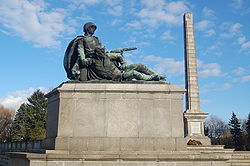
Stalin's adversary, Leon Trotsky, was highly critical of this rigid approach towards the arts.[36] He viewed cultural conformity as an expression of Stalinism in which "the literary schools were strangled one after the other" and the method of command extended across various areas from scientific agriculture to music.[37] Overall, he regarded socialist realism to be an arbitrary construct of the Stalinist bureaucracy.
"In that victorious revolution, there is not only the revolution, but also a new privileged stratum...[which] has strangled artistic creation with a totalitarian hand...Even under absolute monarchy art was based on idealization, but not on falsification, whereas in the Soviet Union official art – and none other exists there – is sharing in the fate of official justice; its purpose is to glorify the "Leader" and to manufacture officially a heroic myth...The style of official Soviet painting is being described as "socialist realism" – the label could have been invented only by a bureaucrat at the head of an Arts Department."[38]
The impact of socialist realist art can still be seen decades after it ceased being the only state-supported style. Even before the end of the USSR in 1991, the government had been reducing its practices of censorship. After Stalin's death in 1953, Nikita Khrushchev began to condemn the previous regime's practice of excessive restrictions. This freedom allowed artists to begin experimenting with new techniques, but the shift was not immediate. It was not until the ultimate fall of Soviet rule that artists were no longer restricted by the deposed Communist Party. Many socialist realist tendencies prevailed until the mid-to-late 1990s and early 2000s.[39]
In the 1990s, many Russian artists used the characteristics of socialist realism in an ironic fashion.[39] This was completely different from what existed only a couple of decades before. Once artists broke from the socialist realist mould, there was a significant power shift. Artists began including subjects that could not exist according to Soviet ideals. Now that the power over appearances was taken away from the government, artists achieved a level of authority that had not existed since the early 20th century.[40] In the decade immediately after the fall of the USSR, artists represented socialist realism and the Soviet legacy as a traumatic event. By the next decade, there was a unique sense of detachment.[41]
Western cultures often do not look at socialist realism positively. Democratic countries view the art produced during this period of repression as a lie.[42] Non-Marxist art historians tend to view communism as a form of totalitarianism that smothers artistic expression and therefore retards the progress of culture.[43] In recent years there has been a reclamation of the movement in Moscow with the addition of the Institute of Russian Realist Art (IRRA), a three-story museum dedicated to preserving 20th-century Russian realist paintings.[44]
Notable works and artists
[edit]This section needs additional citations for verification. (February 2023) |
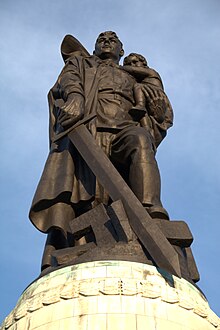
Music
[edit]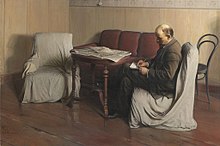
Hanns Eisler composed many workers' songs, marches, and ballads on current political topics such as Song of Solidarity, Song of the United Front, and Song of the Comintern. He was a founder of a new style of revolutionary song for the masses. He also composed works in larger forms such as Requiem for Lenin. Eisler's most important works include the cantatas German Symphony, Serenade of the Age and Song of Peace. Eisler combines features of revolutionary songs with varied expression. His symphonic music is known for its complex and subtle orchestration.[citation needed]
Closely associated with the rise of the labor movement was the development of the revolutionary song, which was performed at demonstrations and meetings. Among the most famous of the revolutionary songs are The Internationale and Whirlwinds of Danger. Notable songs from Russia include Boldly, Comrades, in Step, Workers' Marseillaise, and Rage, Tyrants. Folk and revolutionary songs influenced the Soviet mass songs. The mass song was a leading genre in Soviet music, especially during the 1930s and the war. The mass song influenced other genres, including the art song, opera, and film music. The most popular mass songs include Dunaevsky's Song of the Homeland, Isaakovsky's Katiusha, Novikov's Hymn of Democratic Youth of the World, and Aleksandrov's Sacred War.
Film
[edit]Discussions of film as a tool of the Soviet state began in the early twentieth century. Leon Trotsky argued that cinema is a valuable means for propaganda and education and that it could be used to supplant the influence of the Orthodox Church in Russia.[45]
In the early 1930s, Soviet filmmakers applied socialist realism in their work. Notable films include Chapaev, which shows the role of the people in the history-making process. The theme of revolutionary history was developed in films such as The Youth of Maxim by Grigori Kozintsev and Leonid Trauberg, Shchors by Dovzhenko, and We are from Kronstadt by E. Dzigan. The shaping of the new man under socialism was a theme of films such as A Start Life by N. Ekk, Ivan by Dovzhenko, Valerii Chkalov by M. Kalatozov and the film version of Tanker "Derbent" (1941). Some films depicted the part of peoples of the Soviet Union against foreign invaders: Alexander Nevsky by Eisenstein, Minin and Pozharsky by Pudovkin, and Bogdan Khmelnitsky by Savchenko. Soviet politicians were the subjects in films such as Yutkevich's trilogy of movies about Lenin.
Socialist realism was also applied to Hindi films of the 1940s and 1950s.[citation needed] These include Chetan Anand's Neecha Nagar (1946), which won the Grand Prize at the 1st Cannes Film Festival, and Bimal Roy's Two Acres of Land (1953), which won the International Prize at the 7th Cannes Film Festival.
Paintings
[edit]The painter Aleksandr Deineka provides a notable example for his expressionist and patriotic scenes of the Second World War, collective farms, and sports. Yuriy Ivanovich Pimenov, Boris Ioganson and Geli Korzev have also been described as "unappreciated masters of twentieth-century realism".[46] Another well-known practitioner was Fyodor Pavlovich Reshetnikov.
Socialist realist art found acceptance in the Baltic nations, inspiring many artists. One such artist was Czeslaw Znamierowski (23 May 1890 – 9 August 1977), a Soviet Lithuanian painter, known for his large panoramic landscapes and love of nature. Znamierowski combined these two passions to create very notable paintings in the Soviet Union, earning the prestigious title of Honorable Artist of LSSR in 1965.[47] Born in Latvia, which formed part of the Russian Empire at the time, Znamierowski was of Polish descent and Lithuanian citizenship, a country where he lived for most of his life and died. He excelled in landscapes and social realism, and held many exhibitions. Znamierowski was also widely published in national newspapers, magazines and books.[48] His more notable paintings include Before Rain (1930), Panorama of Vilnius City (1950), The Green Lake (1955), and In Klaipeda Fishing Port (1959). A large collection of his art is located in the Lithuanian Art Museum.[49]
Literature
[edit]Martin Andersen Nexø developed socialist realism in his own way. His creative method featured a combination of publicistic passion, a critical view of capitalist society, and a steadfast striving to bring reality into accord with socialist ideals. The novel Pelle, the Conqueror is considered to be a classic of socialist realism.[citation needed] The novel Ditte, Daughter of Man had a working-class woman as its heroine. He battled against the enemies of socialism in the books Two Worlds, and Hands Off!.
Bruno Apitz's novel Nackt unter Wölfen, a story that culminates in the vivid description of the self-liberation of the detainees,[50] was deliberately chosen to take place on the same day as the formal opening of the Buchenwald Monument in September 1958.[51]
The novels of Louis Aragon, such as The Real World, depict the working class as a rising force of the nation. He published two books of documentary prose, The Communist Man. In the collection of poems A Knife in the Heart Again, Aragon criticizes the penetration of American imperialism into Europe. The novel The Holy Week depicts the artist's path toward the people against a broad social and historical background.[citation needed]
Maxim Gorky's novel Mother (1906) is usually considered to have been the first socialist-realist novel.[52] Gorky was also a major factor in the school's rapid rise, and his pamphlet, On Socialist Realism, essentially lays out the needs of Soviet art. Other important works of literature include Fyodor Gladkov's Cement (1925), Nikolai Ostrovsky's How the Steel Was Tempered (1936) and Aleksey Tolstoy's epic trilogy The Road to Calvary (1922–1941). Yury Krymov's novel Tanker "Derbent" (1938) portrays Soviet merchant seafarers being transformed by the Stakhanovite movement.
Thol, a novel by D. Selvaraj in Tamil is a standing example of Marxist Realism in India. It won a literary award (Sahithya Akademi) for the year 2012.[53]
Sculptures
[edit]Sculptor Fritz Cremer created a series of monuments commemorating the victims of the Nazi regime in the former concentration camps Auschwitz, Buchenwald, Mauthausen and Ravensbrück. His bronze monument in Buchenwald, depicting the liberation of this concentration camp by detainees in April 1945, is considered one of the most striking examples of socialist realism in GDR sculpture for its representation of communist liberation.[citation needed] Each figure in the monument, erected outside the campsite, has symbolic significance according to the orthodox communist interpretation of the event. Thus communists were portrayed as the driving force behind self-liberation, symbolized by a figure in the foreground sacrificing himself for his sufferers, followed by the central group of determined comrades through whose courage and fearlessness is encouraged. The German Democratic Republic used these sculptures to reaffirm its claim to the historical and political legacy of the anti-fascist struggle for freedom.[51]
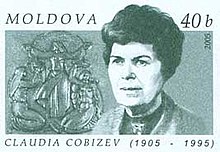
Claudia Cobizev was a Moldovan sculptor, whose work was known for its sensitive portrayals of women and children.[54][55] Her most notable work is Cap de moldoveancă which was exhibited at the Paris International Exhibition to wide acclaim.[56]
Theater
[edit]Theater is a realm in which socialist realism as a movement took root as a way to reach out and appeal to the masses. This occurred both within the Soviet bloc as well as outside of it, with China being another hotbed for socialist realism within theater.
Soviet Union
[edit]
Countries within the Soviet Union were heavily influenced by socialist realism when it came to theater. Early after the 1917 revolution, a movement arose to attempt to redefine what theater was, with theorist Platon Kerzhentsev wanting to break down the barriers between actors and the public, creating unity between the two.[57] This new way of thinking about what theater should be influenced the beginnings of socialist realism within this space, making it more communal and less hierarchical.
With the revolution, there was the ability to change the existing theatrical institutions to fit the new ideas circulating. The early 1920s saw this explosion of creativity, with organizations such as the TEO Narkompros (the Department of Fine Arts) working to incorporate new types of theater.[58] Thus, these movements were later brought under control and solidified by the Soviet government, as individual theatrical troupes were organized and transformed through governmental support.[59]
A part of these movements involved the reinvention of classic shows, including those in the Western canon. Hamlet particularly had a draw for Russians, and was seen to provide insight into the workings and complexities of Russian life after the 1917 revolution.[60] Playwrights attempted to express their feelings about life around them while additionally following the guidelines of socialist realism, a way of reinventing old shows. Hamlet was re-imagined by Nikolay Akimov, for example, as a show that was more materialist in nature, coming at the end of this era of experimentation.[61]
These movements were not merely localized to Russia, but spread throughout the USSR, with Poland being a notable location where socialist realism was implemented in theater. In order to make theater more accessible to the average person (for both entertainment and educational purposes), an emphasis was put on creating a network of smaller, independent theaters, including those in rural communities and traveling companies.[62]
By making theater available to everyone, not simply those with the time and money to view it, officials hoped to educate the public both on theater itself and the various ideologies they wanted to promote. Beliefs that were more heavily promoted included those seen to be educational (with the idea of “teaching through entertaining” springing up), those upholding the values of nature and the countryside, and those that generally had a positive quality, especially when looking at children’s theater.[63]
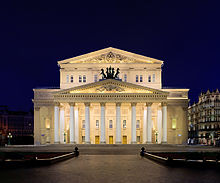
Reinvention of old forms took place, along with the creation of new theatrical movements. Opera as a theatrical form was reinterpreted and reinvented throughout the Soviet Union, moving away from its aristocratic roots and towards the support of the new state.[64] By the 1930s, the Bolshoi Theater in particular became a symbol of Bolshevik power, and the question became how to best integrate socialist realism into an opera that could be performed there.[65] The Union of Soviet Composers, established 1932, played a role towards creating these new operas, and spoke about the importance of socialist realism in opposition to modernistic art.[66]
China
[edit]Though socialist realism was created by and is thought to mainly apply to countries within the Soviet Bloc, China in the late 18th century can be seen to be influenced by similar ideas, often taking direct inspiration from them.

Theater in China fell under the state’s purview after the Chinese Communist Revolution, led partly by poet and playwright Tian Han, President of the China Theater Association (among other honors). He pushed for theatrical reform in a socialist manner, primarily focused on transferring ownership from private troupes to state ones, but additionally on the subject matter of the plays themselves.[67] This focus on private ownership as something to be avoided is similar to concerns seen in the Soviet Union, as is the nationalization of theater.
In the midst of these reforms, ideas around feminism and how it tied into socialism emerged, specifically with regards to theater. Bai Wei, inspired by Tian Han, developed a style of theater in the 1920s that focused specifically on women within a patriarchal society, and the struggle to break free of it.[68] She additionally incorporated ideas of socialist realism within her work, though did break from it in some ways, including the fact that her characters were more individualized and less collective. Strong female characters were, however, idealized and put forward in Chinese socialist realism, with these women often shown making some sort of sacrifice or grand action in service of a greater cause.[69]
Socialist realism in Chinese theater can be seen to hone in on the ideas that it is more valuable to take action as a group, together, than individually. This is evident from plays put on during the Cultural Revolution, where common themes included a large group standing up to imperialist forces (such as a Japanese invasion, for example), with the individual characters within the play being less important than the overarching power struggle occurring.[70] By abstracting the conflicts to those occurring on a higher level, these plays hoped to educate and influence the people watching them.
Soviet Union
[edit]This section needs additional citations for verification. (February 2023) |

In conjunction with the Socialist Classical style of architecture, socialist realism was the officially approved type of art in the Soviet Union for more than fifty years.[71]
In the early years of the Soviet Union, Russian and Soviet artists embraced a wide variety of art forms under the auspices of Proletkult. Revolutionary politics and radical non-traditional art forms were seen as complementary.[72] In art, Constructivism flourished. In poetry, the non-traditional and the avant-garde were often praised.
These styles of art were later rejected by members of the Communist Party who did not appreciate modern styles such as Impressionism and Cubism. Socialist realism was, to some extent, a reaction against the adoption of these "decadent" styles. It was thought by Lenin that the non-representative forms of art were not understood by the proletariat and could therefore not be used by the state for propaganda.[73]
Alexander Bogdanov argued that the radical reformation of society to communist principles meant little if any bourgeois art would prove useful; some of his more radical followers advocated the destruction of libraries and museums.[74] Lenin rejected this philosophy,[75] deplored the rejection of the beautiful because it was old, and explicitly described art as needing to call on its heritage: "Proletarian culture must be the logical development of the store of knowledge mankind has accumulated under the yoke of capitalist, landowner, and bureaucratic society."[76]
Modern art styles appeared to refuse to draw upon this heritage, thus clashing with the long realist tradition in Russia and rendering the art scene complex.[77] Even in Lenin's time, a cultural bureaucracy began to restrain art to fit propaganda purposes.[78] Leon Trotsky's arguments that a "proletarian literature" was un-Marxist because the proletariat would lose its class characteristics in the transition to a classless society, however, did not prevail.[79]

Socialist realism became state policy in 1934 when the First Congress of Soviet Writers met and Stalin's representative Andrei Zhdanov gave a speech strongly endorsing it as "the official style of Soviet culture".[80] It was enforced ruthlessly in all spheres of artistic endeavour. Form and content were often limited, with erotic, religious, abstract, surrealist, and expressionist art being forbidden. Formal experiments, including internal dialogue, stream of consciousness, nonsense, free-form association, and cut-up were also disallowed. This was either because they were "decadent", unintelligible to the proletariat, or counter-revolutionary.
Art exhibitions of 1935–1940 serve as counterpoint to claims that the artistic life of the period was suppressed by the ideology and artists submitted entirely to what was then called "social order". A great number of landscapes, portraits, and genre paintings exhibited at the time pursued purely technical purposes and were thus ostensibly free from any ideology. Genre painting was also approached in a similar way.[81]
Their time and contemporaries, with all its images, ideas, and dispositions found it full expression in portraits by Vladimir Gorb, Boris Korneev, Engels Kozlov, Felix Lembersky, Oleg Lomakin, Samuil Nevelshtein, Victor Oreshnikov, Semion Rotnitsky, Lev Russov, and Leonid Steele; in landscapes by Nikolai Galakhov, Vasily Golubev, Dmitry Maevsky, Sergei Osipov, Vladimir Ovchinnikov, Alexander Semionov, Arseny Semionov, and Nikolai Timkov; and in genre paintings by Andrey Milnikov, Yevsey Moiseenko, Mikhail Natarevich, Yuri Neprintsev, Nikolai Pozdneev, Mikhail Trufanov, Yuri Tulin, Nina Veselova, and others.[citation needed]
In 1974, for instance, a show of unofficial art in a field near Moscow was broken up and the artwork destroyed with a water cannon and bulldozers (see Bulldozer Exhibition). Mikhail Gorbachev's policies of glasnost and perestroika facilitated an explosion of interest in alternative art styles in the late 1980s, but socialist realism remained in limited force as the official state art style until as late as 1991. It was not until after the fall of the Soviet Union that artists were finally freed from state censorship.[82]
Other countries
[edit]This section needs additional citations for verification. (February 2023) |


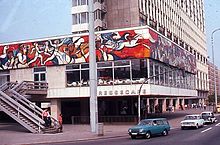
After the Russian Revolution, socialist realism became an international literary movement. Socialist trends in literature were established in the 1920s in Germany, France, Czechoslovakia, and Poland. Writers who helped develop socialist realism in the West included Louis Aragon, Johannes Becher, and Pablo Neruda.[83]
During the 1950s, this massive undertaking, a crucial role fell to architects perceived not as merely engineers creating streets and edifices, but rather as "engineers of the human soul" who, in addition to extending simple aesthetics into urban design, were to express grandiose ideas and arouse feelings of stability, persistence and political power.
In art, from the mid-1960s more relaxed and decorative styles became acceptable even in large public works in the Warsaw Pact bloc, the style mostly deriving from popular posters, illustrations and other works on paper, with discreet influence from their Western equivalents.
Today,[when?] arguably the only countries still focused on these aesthetic principles are North Korea, Laos, and to some extent Vietnam. Socialist realism had little mainstream impact in the non-Communist world, where it was widely seen as a totalitarian means of imposing state control on artists.[84]
The former Socialist Federal Republic of Yugoslavia was an important exception among the communist countries, because after the Tito–Stalin split in 1948, it abandoned socialist realism along with other elements previously imported from the Soviet system and allowed greater artistic freedom.[85]
Socialist realism was the main art current in the People's Socialist Republic of Albania. In 2017, three works by Albanian artists from the socialist era were exhibited at documenta 14.[86]
China
[edit]Academics typically view China's socialist literature as existing within the trend of Stalinist-influenced socialist realism, particularly major works such as Mikhail Sholokov's Virgin Soil Upturned and Galina Nikolaeva's Harvest which were widely translated and disseminated in China.[87] Other academics, including Cai Xiang, Rebecca E. Karl, and Xueping Zhong, place greater weight on the influence of Mao Zedong's 1942 lectures, "Talks at the Yan'an Forum on Art and Literature."[88]
East Germany
[edit]Overview
[edit]The earliest ideas of socialist realism in the GDR came about directly after the end of World War II, when the state was formed. While planning to establish a national East German culture, cultural leaders wanted to move away from fascist ideas, including those of Nazi and militaristic doctrines.[89] Cultural leaders first started clarifying what "realism" entailed. The SED determined that realism was to act as a "fundamental artistic approach that is attuned to contemporary social reality."[90]
The characteristics of realism became more specified in East German cultural policy as the GDR defined its identity as a state. As the head of the SMAD's cultural division, Aleksandr Dymshits asserted that the "negation of reality" and "unbridled fantasy" was a "bourgeois and decadent attitude of the mind" that rejects "the truth of life."[91]
Cultural officials looked back at historical events in Germany that could have acted as the origin points of the eventual creation of the GDR. The works and legacy of Albrecht Dürer became a point of reference for the early development of socialist realism in East Germany. Dürer created many artworks about the Great Peasants' War. His "support for the 'revolutionary forces'" in his illustrations made him an appealing figure to East German officials, while they searched for a starting point of a new German socialist state.[92] In Heinz Lüdecke and Susanne Heiland's anthology Dürer und die Nachwelt, they described Dürer as being "inseparably associated with the two great currents of bourgeois antifeudal progress, namely humanism and the Reformation..."[93] The authors also stated that Dürer came to mind "both by bourgeois self-awareness and by the then awakening German national sense of identity."[94] The legacies of Dürer and the Great Peasants' War continued as artists produced their works in the GDR. Thomas Müntzer was another key figure of historical interest and artistic inspiration for socialist realism in East Germany. Friedrich Engels revered Müntzer for arousing the peasantry to confront the feudal elite.[95]
Visual Art
[edit]Socialist realist visual art in East Germany was unique in its various historical influences. It also stood out with how the art style transcended the boundaries of the art doctrine at times, yet still maintained the goals the state had of communicating early forms of German revolutionary history. Werner Tübke was one of East Germany's most prominent painters, who demonstrated this expansive nature of socialist realist art in his country. Though his paintings did not always conform to the socialist realism doctrine, he was still "able to portray the Socialist utopia, and in particular the understanding of history as held by the Socialist Unity Party of Germany...[96]
Tübke's style drew from the Renaissance art movement, as the GDR also emphasized this style in the creation of artwork, which they referred to as Erbe, or "heritage" art.[97] He cited various Renaissance-era German painters whom he referenced in developing his art style in his Methodisches Handbuch, Dürer being one of them.[98] He made several paintings depicting the lives of the working class and revolutionary struggle, in styles and compositions that resemble the historical German Renaissance paintings. His series of four triptychs called History of the German Working Class Movement was an example of this.[99] Each painting was filled with action taking place on every part of the panel, along with several people in one scene, two common characteristics of German renaissance artwork.
The GDR aimed to use socialist realism to educate the German people about their history, through the lens of working-class struggle, and to evoke a sense of pride for their socialist state. The SED commissioned East German artists "to produce paintings affirming the 'victors of history.'"[100] Werner Tübke was tasked to create his Early Bourgeois Revolution in Germany.[101] The state wanted to have a visual reminder of the German Peasants' War and the leadership of Müntzer in the revolt.[102] The highly detailed mural includes many different scenes and key figures of the revolution. Dürer is included at the bottom of the painting at the fountain. Edith Brandt, the Secretary for Science, Education, and Culture, believed that the mural "would enhance the historical awareness of the population, especially the young, and serve the cause of patriotic education."[103]
East German socialist realism started to shift in later decades, especially after the Basic Treaty, 1972 was signed by both East and West Germany. The treaty allowed East German artists to travel to West Germany and beyond to other European countries.[104] Artistic exchanges between artists in both states introduced these new practices to the GDR, while socialist realism gained more attention by those outside of East Germany. Two exhibitions featuring artwork from both East and West Germany were curated at the Musée d'Art Moderne de la Ville de Paris in 1981.[105] The exhibition for East German art presented itself as "the good founded by socialist realism to better embody a possible alternative to the crisis of values experienced by the West."[106]
Film
[edit]Film was used as a teaching tool for East German cultural values. DEFA was the GDR's official film studio, which created such films.[107] DEFA's socialist realist films were especially geared towards East German youth, as the next generation of the GDR. Leader of the SMAD's propaganda wing, Sergei Tiulpanov, asserted that the primary goal of DEFA was "the struggle to re-educate the German people–especially the young–to a true understanding of genuine democracy and humanism."[108] The studio produced children's films to influence them, as they believed these types of films to be effective in emphasizing good citizenship and how to show children how to emulate this.[109]
Gerhard Lamprecht's Somewhere in Berlin (German: Irgendwo in Berlin) was one of DEFA's most notable films.[110]Though the film was produced in 1946, three years before the GDR was established, it was a foundation point for a broader development of East German socialist realist film. An antifascist film, Lamprecht emphasizes the necessity of "reconstructing the nation" after World War II.[111] Preliminary East German films like Somewhere in Berlin "laid the groundwork for a national film culture based in pedagogical intent."[112]
Some DEFA films were also derived from earlier German fairytales that predated the GDR. Paul Verhoeven's The Cold Heart (German: Das kalte Herz) was one of such films, which was based on the story written by Wilhelm Hauff of the same title.[113] The film was produced to serve as a good example of how a person should treat others. The film's main messages centered on the pitfalls of greed and the value of loving personal relationships.[114]
DEFA also employed films to be used as history lessons for the people of East Germany, namely those about the German Peasants' War. Martin Hellberg's Thomas Muentzer (film) told the stories of his leadership and the revolution in a heroic and idealistic portrayal.[115] DEFA saw Hellberg's film proposal as an opportunity to teach about German revolutionary history, as a means of preventing a descent into fascism again.[116] The producers gave the actor portraying Müntzer lines that embrace Marxist thought, to clearly communicate ideals of socialism and the roles of the working class to viewers.[117] Ideas about property re-distribution and a proletariat victory over the ruling classes are conveyed in the film's depiction of the revolutionary leader.[118]
Literature
[edit]Many of East Germany's renowned writers lived through the Nazi regime, which influenced their craft and works with socialist realism.[119]
Anna Seghers' 1949 novel The Dead Stay Young (German: Die Toten Bleiben Jung) was considered "a foundational literary work for the young GDR."[120] Critics commented on the pessimistic plot and message of the novel, as it was centered on the unsuccessful Spartacist uprising.[121] Though the novel did not depict an ideal or optomistic view on socialism, critic Günther Cwojdrak stated that Seghers still communicated reality by fulfilling "the task of transforming the working people and educating them in the spirit of socialism..."[122]
East German literature that followed Seghers' novel focused on including heroes as protagonists to communicate optimistic messages of the prospects of socialism. Journalist Heinrich Goeres suggested that writers should use Soviet literature as an example to write more positive stories.[123]
Early works of socialist literature in the GDR were produced in 1949 "to promote the new socialist man."[124] In later years, stories about women's lives under socialism were written, and Christa Wolf and Brigitte Reimann were some of the authors who were involved in these widening developments.[125]
In the 1960s, the SED introduced the Bitterfelder Weg, a part of Aufbauliteratur, which was a plan to send writers to industrial centers to generate "cultural production" between the writers and workers.[126]
Gender in socialist realism
[edit]USSR
[edit]Early Soviet period
[edit]
In the poster propaganda produced during the Russian Civil War (1917–1922) men were overrepresented as workers, peasants, and combat heroes, and when women were shown, it was often either to symbolize an abstract concept (e.g., Mother Russia, "freedom") or as nurses and victims.[127] The symbolic women would be depicted as feminine – wearing long dresses, long hair, and bare breasts. The image of the urban proletariat, the group which brought the Bolsheviks to power was characterized by masculinity, physical strength, and dignity and were usually shown as blacksmiths.[127]
In 1920, Soviet artists began to produce the first images of women proletarians. These women differed from the symbolic women from the 1910s in that they most closely resembled the aspects of the male workers – dignity, masculinity, and even supernatural power in the case of blacksmiths.[127] In many paintings in the 1920s, the men and women were almost indistinguishable in stature and clothing, but the women would often be depicted taking subservient roles to the men, such as being his assistant ("rabotnitsa").[127] These women blacksmith figures were less common, but significant, since it was the first time women were represented as proletarians.[127] The introduction of women workers in propaganda coincided with a series of government policies which allowed for divorce, abortion, and more sexual freedom.[128]
Peasant women were also rarely depicted in socialist propaganda art in the period before 1920. The typical image of a peasant was a bearded, sandal-shoed man in shoddy clothes and with a scythe, until 1920, when artists began to create peasant women, who were usually buxom, full-bodied, with a scarf tied around their head.[127] The image of peasant women was not always positive; they often would evoke the derogatory caricature "baba", which was used against peasant women and women in general.[129]
As is discussed above, the art style during the early period of the Soviet Union (1917–1930) differed from the socialist realist art created during the Stalinist period. Artists were able to experiment more freely with the message of the revolution.[129] Many Soviet artists during this period were part of the constructivist movement and used abstract forms for propaganda posters, while some chose to use a realist style.[127] Women artists were significantly represented in the revolutionary avant garde movement, which began before 1917[130] and some of the most famous were Alexandra Exter, Natalia Goncharova, Liubov Popova, Varvara Stepanova, Olga Rozanova and Nadezhda Udaltsova.[130][131][132] These women challenged some of the historical precedents of male dominance in art. Art historian Christina Kiaer has argued that the post-revolutionary shift away from market-based art production was beneficial to female artists' careers, especially before 1930, when the Association of Artists of Revolutionary Russia (AKhRR) was still relatively egalitarian.[133] Instead of an elite, individualistic group of disproportionately male "geniuses"[134] produced by the market, artists shared creation of a common vision.[133][clarification needed]
Stalin era
[edit]The style of socialist realism began to dominate the Soviet artistic community starting when Stalin rose to power in 1930, and the government took a more active role in regulating art creation.[135] The AKhRR became more hierarchical and the association privileged realist style oil paintings, a field dominated by men, over posters and other mediums in which women had primarily worked.[133][135] The task of Soviet artists was to create visualisations of the "New Soviet Man" – the idealized icon of humanity living under socialism. This heroic figure encapsulated both men and women, per the Russian word "chelovek", a masculine term meaning "person".[130] While the new Soviet person could be male or female, the figure of man was often used to represent gender neutrality.[136]
Because the government had declared the "woman question" resolved in 1930, there was little explicit discourse about how women should be uniquely created in art.[137] Discussions of gender difference and sexuality were generally taboo and viewed as a distraction from the duties people had to the creation of socialism.[128] Accordingly, nudes of both men and women were rare, and some art critics have pointed out that Socialist Realist paintings escaped the problem of women's sexual objectification commonly seen in capitalist forms of art production.[128][138] But the declaration of women's equality also made it difficult to talk about the gender inequality that did exist; Stalin's government had simultaneously banned abortion and homosexuality, made divorce more difficult, and dismantled the women's associations in government (Zhenotdels).[128] The "New Soviet Woman" was often shown working in traditionally male jobs, such as aviation, engineering, tractor-driving, and politics.[136] The point of this was to encourage women to join the workforce and show off the strides the USSR had made for women, especially in comparison with the United States.[139] Indeed, women had expanded opportunities to take up traditionally male jobs in comparison to the US. In 1950, women made up 51.8% of the Soviet labor force, compared to just 28.3% in North America.[139]
However, there were also many patriarchal depictions of women. Historian Susan Reid has argued that the cult of personality around male Soviet leaders created an entire atmosphere of patriarchy in Socialist Realist art, where both male and female workers often looked up to the "father" icon of Lenin and Stalin.[135] Furthermore, the policies of the 1930s ended up forcing many women to be solely responsible for childcare, leaving them with the famous "double burden" of childcare and work duties.[136] The government encouraged women to have children by creating portraits of the "housewife-activist" – wives and mothers who supported their husbands and the socialist state by taking on unpaid housework and childcare.[135][136]
Women were also more often shown as peasants than workers, which some scholars see as evidence of their perceived inferiority.[136] Art depicting peasant women in the Stalin era was far more positive than in the 1920s, and often explicitly pushed back against the "baba" stereotype.[129] However, the peasantry, still living in feudal society, was generally seen as backwards, and did not hold the same status as the heroic status as the revolutionary urban proletariat.[136] An example of the gender distinction of male proletariat and female peasantry is Vera Muhkina's statue Worker and Kolkhoz Woman (1937), where the worker is shown as male, while the collective farm worker is female.[136]
Painting
[edit]-
N. Kasatkin. Pioneer-girl with book (1926)
-
Vladimir Pchelin, Lenin Assassination Attempt (1927)
-
Kuzma Petrov-Vodkin, The death of the Political Commissar (1928)
-
Sergey Malyutin, Partisan
-
Wojciech Weiss, Manifesto (1949/1950)
-
Mitrofan Grekov, Trumpeter and standard-bearer (1934)
-
The Green Lake by Czeslaw Znamierowski, 145 x 250 cm, 1955
-
Female Partisan in Battle, National History Museum, Tirana, Albania
-
"We Will Fulfill the Party's Commission!" by Igor Berezovsky, 1957
Sculpture
[edit]-
Socialist-Realist allegories surrounding the Palace of Culture and Science in Warsaw
-
Stone as a Weapon of the Proletariat by Ivan Shadr (1947)
-
Stalin Monument in Prague-Letná (1955–1962)
Reliefs
[edit]-
Relief in Gori, Georgia, the birthplace of Stalin
-
Façade on Marszałkowska Street, Warsaw
-
Façade on Marszałkowska Street, Warsaw
See also
[edit]- Brutalist architecture
- Capitalist realism
- Censorship of images in the Soviet Union
- Communist symbolism
- Derussification in Ukraine
- Fine Art of Leningrad
- Heroic realism
- Lenin's Mausoleum
- Museum of the Chinese Communist Party
- New Moscow (painting)
- Propaganda in the Soviet Union
- Socialist realism in Poland
- Socialist realism in Romania
- Soviet-era statues
- Vanguardism
- Zhdanov Doctrine
References
[edit]- ^ a b Elliott, David; Juszkiewicz, Piotr (2003). "Socialist Realism". Oxford Art Online. Oxford University Press. doi:10.1093/gao/9781884446054.article.t079464. ISBN 978-1-884446-05-4. Retrieved 2023-11-26.
- ^ "Socialist Realism | art". Encyclopedia Britannica.
- ^ Korin, Pavel, "Thoughts on Art", Socialist Realism in Literature and Art. Progress Publishers, Moscow, 1971, p. 95.
- ^ Todd, James G. "Social Realism". Art Terms. Museum of Modern Art, 2009.
- ^ Morson, Gary Saul (1979). "Socialist Realism and Literary Theory" (PDF). The Journal of Aesthetics and Art Criticism. 38 (2): 121–133. doi:10.1111/1540_6245.jaac38.2.0121. JSTOR 430715.
- ^ Stefan Baghiu (January 2016). "Translating Novels in Romania: The Age of Socialist Realism. From an Ideological Center to Geographical Margins".
{{cite journal}}: Cite journal requires|journal=(help) - ^ Encyclopedia Britannica on-line definition of Socialist Realism
- ^ Ellis, Andrew. Socialist Realisms: Soviet Painting 1920–1970. Skira Editore S.p.A., 2012, p. 20
- ^ Valkenier, Elizabeth. Russian Realist Art. Ardis, 1977, p. 3.
- ^ a b Ellis, Andrew. Socialist Realisms: Soviet Painting 1920–1970. Skira Editore S.p.A., 2012, p. 17
- ^ a b c Ellis, Andrew. Socialist Realisms: Soviet Painting 1920–1970. Skira Editore S.p.A., 2012, p. 21
- ^ a b c Ellis, Andrew. Socialist Realisms: Soviet Painting 1920–1970. Skira Editore S.p.A., 2012, p. 22
- ^ Ellis, Andrew. Socialist Realisms: Soviet Painting 1920–1970. Skira Editore S.p.A., 2012, p. 23
- ^ Социалистический реализм. In: Большая российская энциклопедия, 2015, pp. 75–753
- ^ a b Ellis, Andrew. Socialist Realisms: Soviet Painting 1920–1970. Skira Editore S.p.A., 2012, p. 37
- ^ Juraga, Dubravka and Booker, Keith M. Socialist Cultures East and West. Praeger, 2002, p. 68
- ^ a b Nelson, Cary and Lawrence, Grossberg. Marxism and the Interpretation of Culture. University of Illinois Press, 1988, p. 5
- ^ a b c Ellis, Andrew. Socialist Realisms: Soviet Painting 1920–1970. Skira Editore S.p.A., 2012, p. 38
- ^ Tompkins, David G. (2013). Composing the Party Line. Purdue University Press. pp. 17–18.
- ^ "Socialist Realism Movement Overview". The Art Story. Retrieved 2024-06-20.
- ^ Overy, Richard. The Dictators: Hitler's Germany, Stalin's Russia. W.W. Norton & Company, 2004, p. 354
- ^ Schwartz, Lawrence H. Marxism and Culture. Kennikat Press, 1980, p. 110
- ^ Frankel, Tobia. The Russian Artist. Macmillan Company, 1972, p. 125
- ^ Stegelbaum, Lewis and Sokolov, Andrei. Stalinism As A Way Of Life. Yale University Press, 2004, p. 220
- ^ Juraga, Dubravka and Booker, Keith M. Socialist Cultures East and West. Praeger, 2002, p. 45
- ^ "The Artist-Dictator: Stalin as Auteur in the Battle of Utopian Aesthetics | Jake Zawlacki | IJORS International Journal of Russian Studies". www.ijors.net. Retrieved 2023-10-30.
- ^ "Definition of Socialist Realism". www.merriam-webster.com. Retrieved 2019-02-18.
- ^ "Socialist Realism Movement Overview". The Art Story. Retrieved 2019-02-18.
- ^ a b "Socialist Realism – Concepts & Styles". The Art Story. Retrieved 2019-02-18.
- ^ Tate. "Socialist realism – Art Term". Tate. Retrieved 2019-02-18.
- ^ a b Ellis, Andrew. Socialist Realisms: Soviet Painting 1920–1970. Skira Editore S.p.A., 2012, p. 35
- ^ "От основания до современности К 80-летию Студии военных художников имени М.Б. Грекова – Бурение и Нефть – журнал про газ и нефть". burneft.ru.
- ^ "'Надо прекословить!' М. Горький и создание Союза писателей".
- ^ "Gorky on Soviet Literature". Seventeen Moments in Soviet History. August 15, 2015.
- ^ Bennett, James (2017). Subsidizing Culture: Taxpayer Enrichment of the Creative Class. New York: Taylor & Francis. p. 98. ISBN 9781351487726. Retrieved 14 August 2021.
- ^ Deutscher, Isaac (5 January 2015). The Prophet: The Life of Leon Trotsky. Verso Books. pp. 1283, 1360–1361. ISBN 978-1-78168-721-5.
- ^ Deutscher, Isaac (2015). The Prophet: The Life of Leon Trotsky. Verso Books. pp. 1283, 1360–13661. ISBN 978-1-78168-721-5.
- ^ Deutscher, Isaac (2015). The Prophet: The Life of Leon Trotsky. Verso Books. p. 1476. ISBN 978-1-78168-721-5.
- ^ a b Evangeli, Aleksandr. "Echoes of Socialist Realism in Post-Soviet Art", Socialist Realisms: Soviet Painting 1920–1970. Skira Editore S.p.A., 2012, p. 218
- ^ Evangeli, Aleksandr. "Echoes of Socialist Realism in Post-Soviet Art", Socialist Realisms: Soviet Painting 1920–1970. Skira Editore S.p.A., 2012, p. 221
- ^ Evangeli, Aleksandr. "Echoes of Socialist Realism in Post-Soviet Art", Socialist Realisms: Soviet Painting 1920–1970. Skira Editore S.p.A., 2012, p. 223
- ^ Juraga, Dubravka and Booker, Keith M. Socialist Cultures East and West. Praeger, 2002, p. 12
- ^ Schwartz, Lawrence H. Marxism and Culture. Kennikat Press, 1980, p. 4
- ^ Solomon, Tessa (2019-11-11). "Art Acquired by Fugitive Russian Banker Discovered Outside Moscow". ARTnews.com. Retrieved 2022-04-01.
- ^ "Lev Trotsky: Vodka, the Church and the Cinema", The Film Factory, Routledge, pp. 116–118, 2012-10-12, doi:10.4324/9780203059920-29, ISBN 978-0-203-05992-0, retrieved 2024-09-20
- ^ Bartelik, Marek (1999). "Concerning Socialist Realism: Recent Publications on Russian Art (book review)". Art Journal. 58 (4): 90–95. doi:10.2307/777916. JSTOR 777916.
- ^ Alekna, Romas (24 May 1975). "Česlovui Znamierovskiui – 85" [Česlovas Znamierovskis Celebrates his 85th Birthday]. Literatūra ir menas [Literature and Art] (in Lithuanian) (Vilnius: Lithuanian Creative Unions Weekly)
- ^ "Czeslaw Znamierowski". CzeslawZnamierowski. 27 October 2013.
- ^ "Lietuvos dailės muziejus. "Lietuvos tapyba 1940–1990" LDM rinkiniuose saugomų kūrinių katalogas (Elektroninė versija). Z_Ž". Archived from the original on 2015-03-16. Retrieved 2013-11-20.
- ^ mdr.de. "Bruno Apitz und sein Roman 'Nackt unter Wölfen' | MDR.DE". www.mdr.de (in German). Retrieved 2021-01-09.
- ^ a b Rob, Burns (1995). German cultural studies : an introduction. Burns, Rob. New York: Oxford University Press. p. 173. ISBN 0-19-871502-1. OCLC 31934309.
- ^ Andrei Sinyavsky. Maxim Gorky's Mother as the first Socrealist novel
- ^ "Akademi Awards (1955-2020)". Sahitya Akademi: National Academy of Letters. Retrieved June 25, 2021.
- ^ Marian, Ana. "Particularităţile portretului în creaţia Claudiei Cobizev." Arta 1 (AV) (2015): 150–156.
- ^ "Claudia Cobizev a făcut din schiţe adevărate opere de artă". TRM (in Romanian). 2022-01-05. Retrieved 2023-05-13.
- ^ Malcoci, Vitalie. "115 ani de la nașterea celebrei sculptoriţe Claudia Cobizev." Arta 1 (AV) (2020): 175–176.
- ^ Gardiner, Jesse (2023). Soviet Theatre During the Thaw: Aesthetics, Politics, and Performance. New York: Bloomsbury Publishing. p. 23.
- ^ Gérin, Annie (2018). Devastation and Laughter: Satire, Power, and Culture in the Early Soviet State (1920s–1930s). University of Toronto Press. p. 83.
- ^ Mally, Lynn (1993). "Autonomous Theater and the Origins of Socialist Realism: The 1932 Olympiad of Autonomous Art". The Russian Review. 52 (2): 199.
- ^ Morgan, Kim (2021). "Shakespeare, Formalism, and Socialist Realism: The Censured Hamlets of Michael Chekhov and Nikolay Akimov". The Shakespearean International Yearbook. 18: 61 – via Acedemia.edu.
- ^ Morgan, Kim (2021). "Shakespeare, Formalism, and Socialist Realism: The Censured Hamlets of Michael Chekhov and Nikolay Akimov". The Shakespearean International Yearbook. 18: 71 – via Academia.edu.
- ^ Wiśniewska-Grabarczyk, Anna (2016). "Theater and Drama of Socialist Realism in the Context of Cryptotexts". Polish Literary Journal of the University of Lodz. 37 (7): 76 – via ResearchGate.
- ^ Wiśniewska-Grabarczyk, Anna (September 2016). "Theatre and Drama of Socialist Realism in the Context of Cryptotexts". Polish Literary Journal of the University of Lodz. 37 (7): 79–80 – via ResearchGate.
- ^ Kotkina, Irina (2013). "Soviet Empire and Operatic Realm: Stalinist Search for the Model Soviet Opera". Revue des études slaves. 84 (3): 508.
- ^ Kotkina, Irina (2013). "Soviet Empire and Operatic Realm: Stalinist Search for the Model Soviet Opera". Revue des études slaves. 84 (3): 509.
- ^ Kotkina, Irina (2013). "Soviet Empire and Operatic Realm: Stalinist Search for the Model Soviet Opera". Revue des études slaves. 84 (3): 510.
- ^ Chen, Xiaomei (2023). Performing the Socialist State: Modern Chinese Theater and Film Culture. New York: Columbia University Press. p. 144.
- ^ Chen, Xiaomei (2023). Performing the Socialist State: Modern Chinese Theater and Film Culture. New York: Columbia University Press. p. 174.
- ^ Chen, Xiaomei (2023). Performing the Socialist State: Modern Chinese Theater and Film Culture. New York: Columbia University Press. p. 175.
- ^ Odom, Glenn (2014). "Socialist Realism and New Subjectivities: Modern Acting in Gao Xingjian's Cold Theatre". Asian Theatre Journal. 31 (1): 164.
- ^ Ellis, Andrew (2012). Socialist Realisms: Soviet Painting 1920–1970. Skira Editore S.p.A. p. 20.
- ^ Werner Haftmann, Painting in the 20th century, London 1965, vol. 1, p. 196.
- ^ Haftman, p. 196
- ^ Richard Pipes, Russia Under the Bolshevik Regime, p. 288, ISBN 978-0-394-50242-7
- ^ Richard Pipes, Russia Under the Bolshevik Regime, p. 289, ISBN 978-0-394-50242-7
- ^ Oleg Sopontsinsky, Art in the Soviet Union: Painting, Sculpture, Graphic Arts, p. 6 Aurora Art Publishers, Leningrad, 1978
- ^ Oleg Sopontsinsky, Art in the Soviet Union: Painting, Sculpture, Graphic Arts, p. 21 Aurora Art Publishers, Leningrad, 1978
- ^ Richard Pipes, Russia Under the Bolshevik Regime, p. 283, ISBN 978-0-394-50242-7
- ^ R. H. Stacy, Russian Literary Criticism p. 191 ISBN 0-8156-0108-5
- ^ "1934: Writers' Congress". Seventeen Moments in Soviet History. Archived from the original on 8 December 2013. Retrieved 11 December 2013.
- ^ Sergei V. Ivanov, Unknown Socialist Realism. The Leningrad School, [full citation needed]: pp. 29, 32–340. ISBN 978-5-901724-21-7.
- ^ Wren, Christopher S. (September 16, 1974). "Russians Disrupt Modern Art Show". The New York Times. Retrieved 2019-01-16.
- ^ "Социалистический реализм". Archived from the original on 2005-05-08. Retrieved 2009-02-26.
- ^ "Lin Jung-hua. Post-Soviet Aestheticians Rethinking Russianization and Chinization of Marxism//Russian Language and Literature Studies. Serial № 33. Beijing, Capital Normal University, 2011, № 3. pp. 46–53" (PDF). Archived from the original (PDF) on 2012-04-24. Retrieved 2011-10-26.
{{cite web}}: External link in|title= - ^ Library of Congress Country Studies – Yugoslavia: Introduction of Socialist Self-Management
- ^ Gaunt, Jeremy (9 May 2017). "Stirring portraits of communist Albania's women recall different reality". Reuters. Retrieved 25 April 2020.
- ^ Cai, Xiang; 蔡翔 (2016). Revolution and its narratives : China's socialist literary and cultural imaginaries (1949–1966). Rebecca E. Karl, Xueping Zhong, 钟雪萍. Durham: Duke University Press. pp. xvii. ISBN 978-0-8223-7461-9. OCLC 932368688.
- ^ Cai, Xiang; 蔡翔 (2016). Revolution and its narratives : China's socialist literary and cultural imaginaries (1949–1966). Rebecca E. Karl, Xueping Zhong, 钟雪萍. Durham: Duke University Press. pp. xiii–xviii. ISBN 978-0-8223-7461-9. OCLC 932368688.
- ^ Hofer, Sigrid (2012). "The Dürer Heritage in the GDR: The Canon of Socialist Realism, Its Areas of Imprecision, and Its Historical Transformations". Getty Research Journal (4): 2. ISSN 1944-8740.
- ^ Hofer, Sigrid (2012). "The Dürer Heritage in the GDR: The Canon of Socialist Realism, Its Areas of Imprecision, and Its Historical Transformations". Getty Research Journal (4): 2. ISSN 1944-8740.
- ^ Hofer, Sigrid (2012). "The Dürer Heritage in the GDR: The Canon of Socialist Realism, Its Areas of Imprecision, and Its Historical Transformations". Getty Research Journal (4): 2–3. ISSN 1944-8740.
- ^ Hofer, Sigrid (2012). "The Dürer Heritage in the GDR: The Canon of Socialist Realism, Its Areas of Imprecision, and Its Historical Transformations". Getty Research Journal (4): 6–8. ISSN 1944-8740.
- ^ Hofer, Sigrid (2012). "The Dürer Heritage in the GDR: The Canon of Socialist Realism, Its Areas of Imprecision, and Its Historical Transformations". Getty Research Journal (4): 11. ISSN 1944-8740.
- ^ Hofer, Sigrid (2012). "The Dürer Heritage in the GDR: The Canon of Socialist Realism, Its Areas of Imprecision, and Its Historical Transformations". Getty Research Journal (4): 11. ISSN 1944-8740.
- ^ Walinski-Kiehl, Robert (2006). "History, Politics, and East German Film: The Thomas Müntzer (1956) Socialist Epic". Central European History. 39 (1): 31. ISSN 0008-9389.
- ^ Zöllner, Frank (2018). "Werner Tübke's "History of the German Working Class Movement" of 1961 and its Place within his Commissioned Art Works". Artibus et Historiae. 39 (77): 345. ISSN 0391-9064.
- ^ Zöllner, Frank (2018). "Werner Tübke's "History of the German Working Class Movement" of 1961 and its Place within his Commissioned Art Works". Artibus et Historiae. 39 (77): 341. ISSN 0391-9064.
- ^ Zöllner, Frank (2018). "Werner Tübke's "History of the German Working Class Movement" of 1961 and its Place within his Commissioned Art Works". Artibus et Historiae. 39 (77): 341. ISSN 0391-9064.
- ^ Zöllner, Frank (2018). "Werner Tübke's "History of the German Working Class Movement" of 1961 and its Place within his Commissioned Art Works". Artibus et Historiae. 39 (77): 345–355. ISSN 0391-9064.
- ^ Gillen, Eckhart (2011). "'One can and should present an artistic vision... of the end of the world': Werner Tübke's Apocalyptic Panorama in Bad Frankenhausen and the End of the German Democratic Republic". Getty Research Journal (3): 99. ISSN 1944-8740.
- ^ Gillen, Eckhart (2011). ""One can and should present an artistic vision... of the end of the world": Werner Tübke's Apocalyptic Panorama in Bad Frankenhausen and the End of the German Democratic Republic". Getty Research Journal (3): 99. ISSN 1944-8740.
- ^ Gillen, Eckhart (2011). ""One can and should present an artistic vision... of the end of the world": Werner Tübke's Apocalyptic Panorama in Bad Frankenhausen and the End of the German Democratic Republic". Getty Research Journal (3): 100. ISSN 1944-8740.
- ^ Gillen, Eckhart (2011). "'One can and should present an artistic vision... of the end of the world': Werner Tübke's Apocalyptic Panorama in Bad Frankenhausen and the End of the German Democratic Republic". Getty Research Journal (3): 100. ISSN 1944-8740.
- ^ Eisman, April A. (2015). "East German Art and the Permeability of the Berlin Wall". German Studies Review. 38 (3): 605. ISSN 0149-7952.
- ^ Arnoux, Mathilde (2016), Bazin, Jérôme; Glatigny, Pascal Dubourg; Piotrowski, Piotr (eds.), "To Each Their Own Reality: The Art of the FRG and the GDR at the Musée d'Art Moderne de la Ville de Paris in 1981", Art beyond Borders, Artistic Exchange in Communist Europe (1945–1989) (NED – New ed.), Central European University Press, p. 394, doi:10.7829/j.ctt19z397k.34, ISBN 978-963-386-083-0, retrieved 2024-12-06
- ^ Arnoux, Mathilde (2016), Bazin, Jérôme; Glatigny, Pascal Dubourg; Piotrowski, Piotr (eds.), "To Each Their Own Reality: The Art of the FRG and the GDR at the Musée d'Art Moderne de la Ville de Paris in 1981", Art beyond Borders, Artistic Exchange in Communist Europe (1945-1989) (NED – New ed.), Central European University Press, p. 394, doi:10.7829/j.ctt19z397k.34, ISBN 978-963-386-083-0, retrieved 2024-12-06
- ^ Blessing, Benita (2010). "Happily socialist ever after? East German children's films and the education of a fairy tale land". Oxford Review of Education. 36 (2): 234. ISSN 0305-4985.
- ^ Walinski-Kiehl, Robert (2006). "History, Politics, and East German Film: The Thomas Müntzer (1956) Socialist Epic". Central European History. 39 (1): 34. ISSN 0008-9389.
- ^ Blessing, Benita (2010). "Happily socialist ever after? East German children's films and the education of a fairy tale land". Oxford Review of Education. 36 (2): 235. ISSN 0305-4985.
- ^ Blessing, Benita (2010). "Happily socialist ever after? East German children's films and the education of a fairy tale land". Oxford Review of Education. 36 (2): 237. ISSN 0305-4985.
- ^ Blessing, Benita (2010). "Happily socialist ever after? East German children's films and the education of a fairy tale land". Oxford Review of Education. 36 (2): 237. ISSN 0305-4985.
- ^ Blessing, Benita (2010). "Happily socialist ever after? East German children's films and the education of a fairy tale land". Oxford Review of Education. 36 (2): 237. ISSN 0305-4985.
- ^ Blessing, Benita (2010). "Happily socialist ever after? East German children's films and the education of a fairy tale land". Oxford Review of Education. 36 (2): 237. ISSN 0305-4985.
- ^ Blessing, Benita (2010). "Happily socialist ever after? East German children's films and the education of a fairy tale land". Oxford Review of Education. 36 (2): 237–238. ISSN 0305-4985.
- ^ Walinski-Kiehl, Robert (2006). "History, Politics, and East German Film: The Thomas Müntzer (1956) Socialist Epic". Central European History. 39 (1): 30–55. ISSN 0008-9389.
- ^ Walinski-Kiehl, Robert (2006). "History, Politics, and East German Film: The Thomas Müntzer (1956) Socialist Epic". Central European History. 39 (1): 35. ISSN 0008-9389.
- ^ Walinski-Kiehl, Robert (2006). "History, Politics, and East German Film: The Thomas Müntzer (1956) Socialist Epic". Central European History. 39 (1): 48. ISSN 0008-9389.
- ^ Walinski-Kiehl, Robert (2006). "History, Politics, and East German Film: The Thomas Müntzer (1956) Socialist Epic". Central European History. 39 (1): 48. ISSN 0008-9389.
- ^ Nelson, Max (2022). "Half-Truths Are Lies Too: Brigitte Reimann's personal history of East Germany". The Baffler (63): 104. ISSN 1059-9789.
- ^ Brockmann, Stephen (December 21, 2015). The Writers' State: Constructing East German Literature, 1945-1959 (1 ed.). Rochester, NY: Camden House. p. 139. ISBN 9781782046813.
{{cite book}}: CS1 maint: date and year (link) - ^ Brockmann, Stephen (December 21, 2015). The Writers' State: Constructing East German Literature, 1945-1959 (1 ed.). Rochester, NY: Camden House. p. 140. ISBN 9781782046813.
{{cite book}}: CS1 maint: date and year (link) - ^ Brockmann, Stephen (December 21, 2015). The Writers' State: Constructing East German Literature, 1945-1959 (1 ed.). Rochester, NY: Camden House. p. 143. ISBN 9781782046813.
{{cite book}}: CS1 maint: date and year (link) - ^ Brockmann, Stephen (December 21, 2015). The Writers' State: Constructing East German Literature, 1945-1959 (1 ed.). Rochester, NY: Camden House. p. 171. ISBN 9781782046813.
{{cite book}}: CS1 maint: date and year (link) - ^ Heiduschke, Sebastian (2014). "Inspiring and Educating gdr Women: Iris Gusner, Feminism, and the Film Kaskade Rückwärts". Women in German Yearbook. 30: 23–43. doi:10.5250/womgeryearbook.30.2014.0023. ISSN 1058-7446.
- ^ Heiduschke, Sebastian (2014). "Inspiring and Educating gdr Women: Iris Gusner, Feminism, and the Film Kaskade Rückwärts". Women in German Yearbook. 30: 28–29. doi:10.5250/womgeryearbook.30.2014.0023. ISSN 1058-7446.
- ^ Nelson, Max (2022). "Half-Truths Are Lies Too: Brigitte Reimann's personal history of East Germany". The Baffler (63): 103. ISSN 1059-9789.
- ^ a b c d e f g Bonnell, Victoria E. (1991). "The Representation of Women in Early Soviet Political Art". The Russian Review. 50 (3): 267–288. doi:10.2307/131074. ISSN 0036-0341. JSTOR 131074.
- ^ a b c d Simpson, Pat (2004-01-01). "The Nude in Soviet Socialist Realism: Eugenics and Images of the New Person in the 1920s-1940s". Australian and New Zealand Journal of Art. 5 (1): 113–137. doi:10.1080/14434318.2004.11432735. ISSN 1443-4318. S2CID 157757526.
- ^ a b c Bonnell, Victoria E. (1993). "The Peasant Woman in Stalinist Political Art of the 1930s". The American Historical Review. 98 (1): 55–82. doi:10.2307/2166382. ISSN 0002-8762. JSTOR 2166382.
- ^ a b c Lavery, Rena, Ivan Lindsay, and Katia Kapushesky. 2019. Soviet women and their art: the spirit of equality.
- ^ Larkin, Charlotte (17 Nov 2017). "Women of the Avant-Garde". Sotheby's.
- ^ Tate. "The short life of the equal woman: by Christina Kiaer – Tate Etc". Tate. Retrieved 2020-12-04.
- ^ a b c Kiaer, C. H. (2012). Fairy Tales of the Proletariat, or, Is Socialist Realism Kitsch? In Socialist Realisms: Soviet Painting 1920–1970 (pp. 183–189). Skira.
- ^ Fredriksson, Martin (2007-05-01). "The Avant-Gardist, the Male Genius and the Proprietor". Nordlit (21): 275–284. doi:10.7557/13.1785. ISSN 1503-2086.
- ^ a b c d Reid, Susan E. (1998). "All Stalin's Women: Gender and Power in Soviet Art of the 1930s". Slavic Review. 57 (1): 133–173. doi:10.2307/2502056. ISSN 0037-6779. JSTOR 2502056. S2CID 163795609.
- ^ a b c d e f g Simpson, Pat (2004). "Parading Myths: Imaging New Soviet Woman on Fizkul'turnik's Day, July 1944". The Russian Review. 63 (2): 187–211. doi:10.1111/j.1467-9434.2004.00313.x. hdl:2299/616. ISSN 0036-0341. JSTOR 3664081.
- ^ Simpson, Pat (1998). "On the Margins of Discourse? Visions of New Soviet Woman in Socialist Realistic Painting 1949–50". Art History. 21 (2): 247–267. doi:10.1111/1467-8365.00105. ISSN 1467-8365.
- ^ Quan, Hong (2019-12-01). "The representation and/or repression of Chinese women: from a socialist aesthetics to commodity fetish". Neohelicon. 46 (2): 717–737. doi:10.1007/s11059-019-00487-0. ISSN 1588-2810. S2CID 189874839.
- ^ a b Ghodsee, Kristen (2018). Why Women Have Better Sex Under Socialism. United States: Bold Type Books. p. 36. ISBN 9781645036364.
Further reading
[edit]- Bek, Mikuláš; Chew, Geoffrey; and Macel, Petr (eds.). Socialist Realism and Music. Musicological Colloquium at the Brno International Music Festival 36. Prague: KLP; Brno: Institute of Musicology, Masaryk University, 2004. ISBN 80-86791-18-1
- Golomstock, Igor. Totalitarian Art in the Soviet Union, the Third Reich, Fascist Italy and the People's Republic of China, HarperCollins, 1990.
- James, C. Vaughan. Soviet Socialist Realism: Origins and Theory. New York: St. Martin's Press, 1973.
- Ivanov, Sergei. Unknown Socialist Realism. The Leningrad School. Saint Petersburg, NP-Print, 2007 ISBN 978-5-901724-21-7
- Lin Jung-hua. Post-Soviet Aestheticians Rethinking Russianization and Chinization of Marxism (Russian Language and Literature Studies. Serial No. 33) Beijing, Capital Normal University, 2011, No.3. pp. 46–53.
- Prokhorov, Gleb. Art under Socialist Realism: Soviet Painting, 1930–1950. East Roseville, NSW, Australia: Craftsman House; G + B Arts International, 1995. ISBN 976-8097-83-3
- Rideout, Walter B. The Radical Novel in the United States: 1900–1954. Some Interrelations of Literature and Society. New York: Hill and Wang, 1966.
- Saehrendt, Christian. Kunst als Botschafter einer künstlichen Nation ("Art from an artificial nation – about modern art as a tool of the GDR's propaganda"), Stuttgart 2009
- Sinyavsky, Andrei [writing as Abram Tertz]. "The Trial Begins" and "On Socialist Realism", translated by Max Hayward and George Dennis, with an introduction by Czesław Miłosz. Berkeley: University of California Press, 1960–1982. ISBN 0-520-04677-3
- The Leningrad School of Painting. Essays on the History. St Petersburg, ARKA Gallery Publishing, 2019. ISBN 978-5-6042574-2-5
- Origin of Socialist Realism in Russia and China. Translation and revised version of "Las noches rusas y el origen del realismo socialista."

